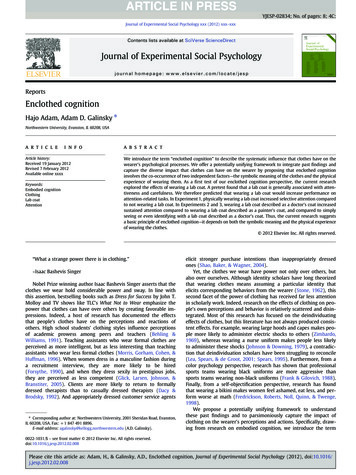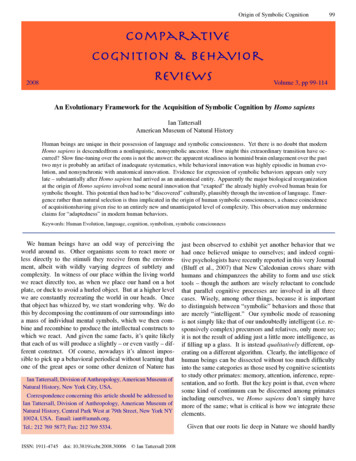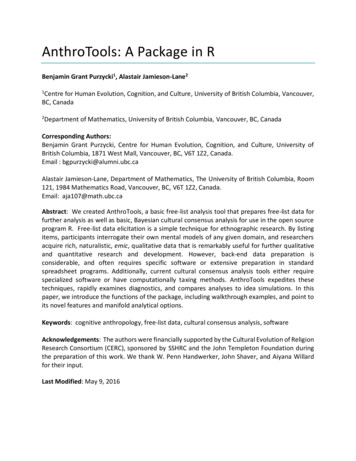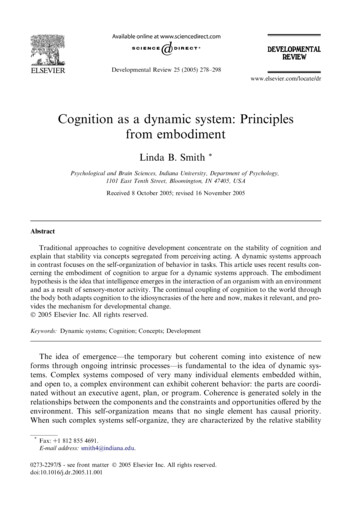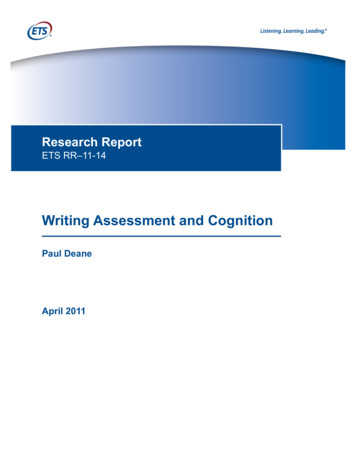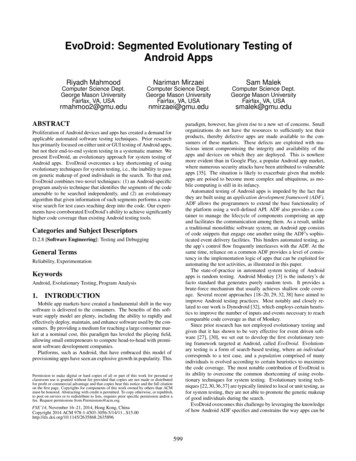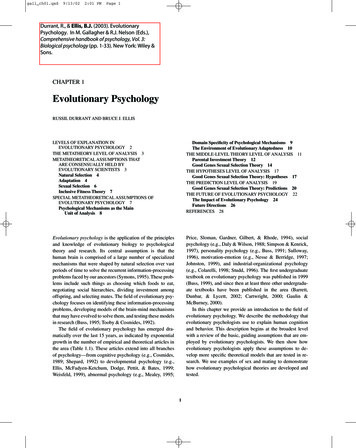
Transcription
Chapter 1Evolutionary Social CognitionPSYCHOLOGICALAthe success with which humans address recurringchallenges to reproductive fitness (Buss, 1995; Ketelaar & Ellis, 2000; Tooby & Cosmides, 1992).As with other metatheoretical approaches—forexample, social psychology or cognitive science—evolutionary psychology is a set of assumptions thatenable one to derive specific theories, models, andhypotheses that are themselves testable and subjectto invalidation. Also, as with any metatheoreticalapproach, it can be evaluated against four importantstandards for scientific success: (a) its logical coherence; (b) its ability to enable the rigorous deductionof specific theories that explain the phenomena ofpsychology as we currently know them; (c) its ability to generate testable hypotheses that are interesting, novel, nuanced, and ultimately supported bydata; and (d) its ability to connect phenomena at different levels of analysis and description. Judgedagainst these criteria, the evolutionary approach tosocial psychology has proven to be quite successful(Neuberg, Kenrick, & Schaller, 2010).We focus here on evolutionary social cognition—how everyday cognition is tied to the fundamental,recurring adaptive challenges of social life. We beginby articulating the logical foundations of evolutionary social cognition. We then discuss theways in which evolutionary social cognition isinherently motivated social cognition and subsequently review a rapidly growing body of researchdemonstrating the presence of adaptation-based,functional social-cognitive processes aimed at managing challenges of self-protection, diseaseavoidance, resource acquisition, social affiliation,UNCORRECTEDPROOFS AMERICANIt is nearly trite to note that the human social worldis complex, dynamic, and rich in information. It isalso a well-worn trope in psychology that the humanmind lacks the capacity to process all this information, online or otherwise. So what’s a mind to do?The answer is that the mind attends to some bitsof information while ignoring others, uses a varietyof mental shortcuts to reduce processing load, andgenerally engages a wide range of simplifying processes to muddle through in the face of an otherwisedaunting task. Such social cognition is often viewedas irrational and error prone, with ill consequencesfor both perceivers and perceived.The social mind is indeed a biased social information processor, but it is not arbitrarily biased.Rather, it is designed for a very specific purpose—apurpose that helps explain the ways in which, andwhy, social cognition is indeed focused and selective and biased. The mind is not designed to makeperfectly correct decisions, and it is not designed tohelp people achieve happiness, a sense of controlover their lives, or some greater meaning, althoughit may sometimes appear that way. Rather, the ultimate purpose of the mind is to enable people tomanage the very real, very tangible opportunitiesand threats that humans have recurrently confronted across their evolutionary history insuch a way as to enhance the individual’s reproductive fitness.The metatheory of evolutionary psychologyassumes that the human brain, like all aspects of thehuman body, has been shaped by biological selection processes, with the general effect of increasingSSOCIATIONSteven L. Neuberg and Mark Schallerhttp://dx.doi.org/10.1037/14341.001APA Handbook of Personality and Social Psychology: Vol. 1. Attitudes and Social Cognition, M. Mikulincer and P. R. Shaver (Editors-in-Chief)Copyright 2015 by the American Psychological Association. All rights reserved.BK-APA-HPS-V1-131228-Chp01.indd 3325/10/13 7:27 PM
Neuberg and SchallerOOFS AMERNTIOCIAOSSALAICGLOOCHYICAAn evolutionary perspective on social cognitionassumes two elementary principles of genetic evolution and developmental biology. First, the genes thatdefine contemporary human populations are theproduct of a long history of evolution by naturalselection. This principle is noncontroversial. Second, the human nervous system typically develops according to a recipe encoded in those genes.This principle, too, is noncontroversial. When integrated, the following statement logically follows:The human nervous system is characterized by stimulus–response mechanisms of specific kindsthat, compared with plausible alternative mechanisms, generally had positive implications for thereproductive fitness of the genes that make up therecipe for constructing the human nervous system.This sentence is dense and requires some carefulunpacking to be clear about what it says (and doesnot say). As we unpack it, we highlight 10 elementsessential to the logic of an evolutionary approach topsychology, in general, and to social cognition,specifically.PSLOGICAL FOUNDATIONS OFEVOLUTIONARY SOCIAL COGNITIONto social cognition. Consider Cosmides’ classic work(e.g., Cosmides, 1989; Cosmides & Tooby, 2005)on cheater detection. Using the Wason selectiontask, which in its typical, abstract operationalizationsuggests striking flaws in people’s reasoning ability,Cosmides and colleagues demonstrated that peopleinstead perform quite well when the task is framedin the context of a social exchange relationship.Their conclusion—that this enhanced performancereflects an underlying set of cognitive adaptationsthat evolved as a means of detecting nonreciprocators in exchange relationships—is buttressed by arange of findings, including evidence that this pattern of reasoning is also evident in many culturalpopulations, including nonliterate Amazonianhunter–horticulturists (e.g., Harris, Núñez, & Brett,2001; Sugiyama, Tooby, & Cosmides, 2002).The assumption of universality does not, however, imply homogeneity in psychological responding, any more than an evolutionary approach togenetics implies that all people must be clones. Ofcourse there are individual differences in humancognition and cultural differences, too. An evolutionary approach does implicitly assume, however,that although differences may be found at one levelof psychological analysis, many of these differencesmay reflect universal psychological mechanismsoperating at another, deeper level of analysis(Norenzayan, Schaller, & Heine, 2006). One potential value of an evolutionary approach is that it compels researchers to try to identify those deeper (oftennonobvious) underlying universal mechanisms.Nstatus acquisition, mate seeking, mate retention, andkin care. We close by briefly revisiting big lessonsand highlighting promising arenas for future theorizing and exploration.“The Human Nervous System . . .”UNCORRECTEDPRWe purposely use the word human to imply universality across all Homo sapiens. Underlying any evolutionary approach to social cognition is theassumption that the basic mechanisms of humanpsychology are universal across all normally developing individuals in all contemporary human populations. An evolutionary approach to socialcognition is thus dedicated to the elucidation ofsocial-cognitive processes relevant to all peopleeverywhere.For this reason, just as cross-cultural evidencecontributes to conclusions about the evolutionarybases of emotions (e.g., Ekman & Friesen, 1971;Tracy & Robins, 2008), cross-cultural research alsoplays an important role in evolutionary approaches“Is Characterized by Stimulus–ResponseMechanisms . . .”Many social-cognitive phenomena function as stimulus–response mechanisms, in which specificsets of psychological inputs trigger specific kinds ofpsychological outputs (e.g., the visual perception ofsymmetrical facial features elicits the inference thatthe face is physically attractive; G. Miller & Todd,1998). These stimulus–response relations oftenoccur in cascades, in which a psychological responsestimulates further responses, as when the inferencethat someone is physically attractive elicits additional emotional, cognitive, and behavioralresponses. In many cases, the presence or magnitude4BK-APA-HPS-V1-131228-Chp01.indd 425/10/13 7:27 PM
Evolutionary Social CognitionPSYCHOLOGICALASSOCIATIONon the basis of observed behavior, social identity–based inference processes through which negative out-group stereotypes are formed, retrieval processes through which information is activated intoworking memory). Underlying much of this traditional process-oriented research is the tacitassumption that the content of these processes isirrelevant or, at least, interchangeable. For example, the same attribution processes are presumed tounderlie inferences about friendliness, nervousness, or attitudes about communism; the samesocial identity processes are seen to contribute tostereotypes about ignorance, untrustworthiness, orcriminal behavior; and the same implicit memoryprocesses are invoked regardless of what kind ofinformation might be available for retrieval intoworking memory.Evolutionary approaches have revealed that thistacit assumption overlooks deeper nuances pertaining to the psychological processes throughwhich people cognitively respond to their socialenvironment. Just as unique brain structures areused when processing specific kinds of visual stimuliassociated with unique evolutionary implications(e.g., the human body, faces; Downing, Jiang, Shuman, & Kanwisher, 2001; Kanwisher, McDermott,& Chun, 1997), unique reasoning mechanismsappear to be used when making decisions in specific kinds of social contexts that had unique evolutionary implications (e.g., social exchange contexts;Cosmides, 1989). The same principle appliesbroadly across a wide range of social-cognitive phenomena. People may more readily form impressionsabout some specific traits rather than others; peoplemay more readily form stereotypes that discriminate along some specific negative attributes ratherthan others; and particular kinds of stereotypes,rather than others, may be especially likely to beactivated into working memory. Predictions aboutthese content-specific responses are readily deducible when one rigorously applies the logical tools ofevolutionary psychology. The result is a body ofresearch that not only contributes in novel ways tothe understanding of social-cognitive processes butalso reveals many novel conclusions about thehighly specific content of inferences and attitudesthat emerge from those processes.NCORRECTEDPROOFS AMERICANof a particular stimulus–response relation is itselfresponsive to the presence of other stimuli. Forexample, the perception of symmetrical facial features may elicit rather different emotional, cognitive, and behavioral responses, depending onwhether it is an opposite-sex or same-sex face ordepending on the broader social context in whichthe face is perceived. A large part of this chapterfocuses on how certain perceiver goals—themselvestypically engaged by stimuli in the environment—act to modulate not only which stimuli in the socialenvironment are perceived and attended to in thefirst place but also the responses these stimuli elicit.Evolved cognitive mechanisms tend not to operatein a fixed and closed manner but rather in a contextually contingent, situationally sensitive, and openmanner (Mayr, 1976).Whereas traditional research on social cognitionis devoted to describing and explaining these kindsof stimulus–response relations in terms of mechanisms operating at an individual level of analysis, arigorous evolutionary approach to social cognitionrequires that researchers also articulate the population-level evolutionary processes that explain howthese stimulus–response mechanisms came to characterize humans in the first place. In other words, anevolutionary approach to social cognition is definedby attempts to integrate proximate explanations ofhuman social cognition with ultimate explanationsas well. A considerable body of research has nowemerged identifying the adaptive implications thatspecific physical features (including facial symmetry) have in the context of mating relationships,which in turn have empirically testable implicationsfor the cognitive, emotional, and behavioralresponses triggered by those features and traits andfor the contexts under which those responses areeither muted or exaggerated (e.g., G. Miller & Todd,1998; Neuberg et al., 2010).U“Of Specific Kinds That . . .”Evolutionary analyses of social cognition frequentlyyield hypotheses highly specific in terms of content. This content specificity stands in contrast tomany other approaches to social cognition thatfocus primarily on process (e.g., attribution processes through which individuals form impressions5BK-APA-HPS-V1-131228-Chp01.indd 525/10/13 7:27 PM
Neuberg and Schaller“Compared With Plausible AlternativeMechanisms . . .”NPSYCHOLOGICALASSOCIATIONPeople sometimes assume that evolution createsoptimal organisms, with the implication that anyevolved mental mechanism should be just aboutperfect. This assumption is wrong. People sometimes also assume the corollary that evolutionaryprocesses cannot legitimately be used to explainimperfect processes. This assumption is also wrong.Natural selection is not a forward-looking, creativeprocess. Rather, it is a winnowing process, the outcomes of which are constrained by available geneticalternatives. If the available alternatives are genesthat make people dumb and genes that make peopledumber, then evolutionary processes may produce apopulation that is dumb rather than dumber. Theycannot, however, produce a population any smarterthan that.Evolution is also constrained by basic principlesof physics, chemistry, and biology. Consider, forexample, psychological mechanisms used in the service of recognizing kin. To inhibit incest (whichcan impose costs on reproductive fitness) and tofacilitate nepotism (which can benefit reproductivefitness), adaptive advantages would have been associated with mental mechanisms enabling perceiversto discriminate between other individuals accordingto their degree of genetic relatedness. An idealmechanism for doing so would provide instant perceptual access to another individual’s actualgenetic makeup and would compute an unerringindex of self–other genetic similarity. Any suchmagical mechanism is as physically implausible asX-ray vision. Instead, the problem of kin recognitionin humans and other animals appears to have beensolved by the evolution of stimulus–response mechanisms sensitive to superficial cues (e.g., facialresemblance) that are correlated with kinship, albeitimperfectly (Lieberman, Tooby, & Cosmides, 2007;Park, Schaller, & Van Vugt, 2008). The imperfectdiagnosticity of these cues results in predictableinference errors in which kin are sometimes treatedas nonkin and nonkin are sometime treated askin—an important point we elaborate on in thenext section.Evolutionary processes are additionally constrainedby the cumulative physiological consequences ofUNCORRECTEDPROOFS AMERICAOne illustrative line of research has exploredinferential responses to babyish facial features.Adaptive behavioral responses to neonatal offspring(e.g., the provision of parental care) would havebeen facilitated by cognitive mechanisms implicitlylinking certain perceptual stimuli (e.g., babyish features) to inferences about traits characteristic ofindividuals requiring care (e.g., “This individual isincapable of taking care of him- or herself and isworthy of my assistance”). One consequence of thisstimulus–response mechanism is that perceiversdraw these implicit inferences not only about babiesbut also about a predictable subset of adults, too:Baby-faced men are judged to be relatively nice butalso relatively naïve and incompetent (Zebrowitz &Montepare, 2006; see Chapter 7, this volume). Notethat baby-facedness does not elicit a generally positive overall impression or a generally negativeoverall impression. Rather, it simultaneously elicits avery specific kind of positive impression (nice ratherthan nasty) and a very specific kind of negativeimpression (incapable rather than capable).The same point is also illustrated by research documenting highly specific linkages between perceivedthreats and the contents of group prejudices. Members of different social groups are perceived to posedifferent kinds of threats to survival and reproduction. For instance, European American undergraduates in one study perceived Mexican Americans asposing a threat to physical safety, whereas they perceived gay men as posing a threat to health (Cottrell& Neuberg, 2005). An evolutionary approach toprejudice implies that these distinct forms of threatare likely to elicit qualitatively distinct kinds of prejudicial responses, and they do: Mexican Americanselicited more fear than did gay men, whereas gay menelicited more disgust than did Mexican Americans(Cottrell & Neuberg, 2005). It is worth noting thatthe overall evaluative attitude toward both groupswas equally negative and that these superficially similar attitudes masked fundamental differences in theirspecific affective and connotative contents.Unlike many other approaches, then, the evolutionary approach often makes novel, nuanced predictions about the content of social cognition. Toevolutionary social cognitivists, content, as well asprocess, matters.6BK-APA-HPS-V1-131228-Chp01.indd 625/10/13 7:27 PM
Evolutionary Social CognitionPSYCHOLOGICALASSOCIATIONi diosyncratic to one particular instance or one particular individual. A particular cognitive dispositionmay have had no beneficial implications at all undermany circumstances (and may even have been costlyunder some circumstances) yet may still haveproven evolutionarily adaptive when considering itsrelative reproductive benefits across all circumstances and across all individuals in a population.This point attests further to the inevitable imperfection of evolved psychological processes and alsosuggests that the exact nature of those imperfectionscan be predicted by applying a cost–benefit logic thatunderlies rigorous evolutionary theorizing. One useful logical tool is the smoke detector principle(Nesse, 2005), in which the adapted design of thehuman mind is likened, metaphorically, to the intentional design of smoke detectors that homeownersinstall on their ceilings. Smoke detectors are signaldetection devices and have the potential to makefalse positive errors (erroneously signaling the presence of a house fire when there is no such fire) andfalse negative errors (erroneously failing to signal thepresence of an actual fire). Any attempt to systematically minimize one kind of error increases the likelihood of the other. Both errors are equally erroneous,but they differ greatly in their costs: False-positiveerrors are merely irritating, whereas false-negativeerrors can be devastating. For this reason, smokedetectors are deliberately calibrated to minimize thepossibility of a false-negative error, with the inevitable consequence that they make many false-positiveerrors. Analogously, many psychological stimulus–response mechanisms also serve a signal detectionfunction (e.g., the detection of anger, or kinship, orfertility) and so also have the potential to produceboth false-positive and false-negative errors. Theseerrors also typically differ in their costly implicationsfor reproductive fitness and so, as a result of naturalselection processes, these mechanisms show predictable adaptive biases: They err on the side of minimizing the likelihood of the most costly errors, with theinevitable consequence that they instead producemany errors of a less costly kind (Haselton & Nettle,2006). This principle, and the evolutionary cost–benefit logic that underlies it, can be used to deducenovel predictions pertaining to the biases and errorsthat characterize social cognition.UNCORRECTEDPROOFS AMERICAN revious evolutionary adaptations—which may bepimpossible to undo even if they are no longer functionally useful. For example, relatively recent evolutionary adaptations in neocortical physiology endowhumans with the capacity to use logical reasoningprocesses and abstract symbols (e.g., linguistic labelsfor kin members) to ascertain another person’sdegree of genetic relatedness with formidable accuracy. In an ideal world, perhaps, the evolutionaryemergence of these neocortical capacities would beaccompanied by the simultaneous disappearance ofthe older, cruder (and more error-prone) cue-basedkin recognition mechanisms. However, that is rarelythe way evolution works. Inferences about kinshipcontinue to be implicitly informed by evolutionarilyancient cue-based stimulus–response mechanisms,which has broad implications. Even in interactionswith total strangers, for instance, phenotypic resemblance triggers kin-connoting inferences. Oppositesex strangers with faces that merely resemble theperceiver’s own are judged both as more trustworthyand as less sexually attractive—a pair of inferencesthat makes good sense for actual kin (DeBruine,2005). Attitude similarity may also serve as a heuristic cue for kinship: Compared with strangers withdissimilar attitudes, attitudinally similar strangers areimplicitly associated with semantic concepts connoting kinship (Park & Schaller, 2005). The intriguingimplication is that many social psychological consequences of incidental similarities—including similarities that ostensibly have nothing to do with familialrelationships at all—may result, in part, from theimplicit operation of ancient cue-based mechanismsof kin recognition. These phenomena include thewell-documented effects of attitude similarity oninterpersonal liking, the effects of nominal similarityon preferences and decision making (i.e., the name–letter effect), and the effects of various arbitrary similarities (such as sharing a birthdate) on achievementmotivation and task performance (e.g., Byrne, 1961;J. T. Jones, Pelham, Carvallo, & Mirenberg, 2004;Walton, Cohen, Cwir, & Spencer, 2012; for a review,see Park et al., 2008).“Generally . . .”The adaptive implications of psychologicalresponses cannot be revealed by consequences7BK-APA-HPS-V1-131228-Chp01.indd 725/10/13 7:27 PM
Neuberg and SchallerNPSYCHOLOGICALASSOCIATIONalso by menopause). Each individual offspring hasthus been of greater reproductive value to femalesthan to males, with the implication that femalemammals tend to be pickier in their choice of malemates: The extent to which male mates are capableof producing genetically fit offspring, and are willingto invest resources in offspring care, has beengreatly important. For female perceivers, then, thereproductive cost of erroneously inferring positivequalities in a potential mate (a false-positive error)was typically greater than the cost of failing to perceive positive qualities that actually exist (a falsenegative error). The adaptive implication of this costasymmetry is a female bias toward skepticism aboutthe positive qualities of potential mates (Haselton &Buss, 2000). In contrast, for male perceivers, thecost of failing to avail oneself of a willing mate (afalse-negative error) was typically greater than thecost of erroneously inferring a willingness that didnot actually exist (a false-positive error). The adaptive implication is a male bias toward overperceivingfemale sexual desire (Haselton & Buss, 2000).Evolved social-cognitive mechanisms are thusnot expected to generate perfect outcomes. Rather,the very nature of their design—to avoid errors that,generally, are highly reproductively costly—meansthat these mechanisms will inevitably generate a different set of predictable, but less reproductivelycostly, errors.UNCORRECTEDPROOFS AMERICAOne illustrative application of the smoke detector principle can be found in a line of research linking interpersonal prejudice to the psychology ofdisease avoidance. Infectious diseases posed a threatto survival (and thus to reproductive fitness)throughout human evolutionary history. As a consequence, a behavioral immune system appears tohave evolved (Schaller, 2011; Schaller & Park,2011). It is characterized by psychological mechanisms that respond adversely to perceptual cuesconnoting the presence of disease-causing pathogens in other individuals (e.g., anomalous morphological features). Because these superficial cues areonly imperfectly correlated with actual infection,however, inference errors are inevitable. False-positive errors lead to the avoidance of healthy people(who are erroneously judged to be infectious); falsenegative errors lead to failures to avoid infectiouspeople (who are erroneously judged to be healthy).False-positive errors typically have minimal consequences for perceivers, but false-negative errors canbe fatal. In accordance with the smoke detectorprinciple, the behavioral immune system is characterized by an adaptive inference bias that minimizesthe likelihood of false-negative errors, with the consequence that it makes many false-positive errorsinstead. Thus, even when people have rationalknowledge to the contrary, the perception of anomalous physical features in other people can triggeraversive responses characterized by disgust and theautomatic activation of disease-relevant semanticconcepts into working memory. These mechanismscontribute uniquely to prejudices against peoplewho are obese, elderly, or physically disabled (Duncan& Schaller, 2009; Park, Faulkner, & Schaller, 2003;Park, Schaller, & Crandall, 2007) and to ethnocentrism and xenophobia as well (Faulkner, Schaller,Park, & Duncan, 2004; Navarrete & Fessler, 2006).The evolutionary logic of error management alsohas implications for sex differences in social inference biases within cross-sex interactions. Throughout evolutionary history, female mammals havebeen obligated by physiology to make a largerinvestment per offspring than males (differentialparental investment). The maximum number of offspring that a female can produce is also smaller(constrained not only by gestation and lactation but“Had . . .”The emphasis here is not on the verb itself but onthe fact that it is expressed in the past tense: had(not has). This is important. It is an empirical question whether any particular psychological phenomenon has positive implications for futurereproductive fitness within contemporary ecologicalcircumstances. Moreover, although this question ofcurrent adaptiveness may interest some scholarswho study human behavioral ecology, it is mostlyirrelevant to scientific inquiry into social cognition.Although there is no reason to assume that any psychological phenomenon has implications for fitnesswithin contemporary ecologies, very good reasonsexist to assume that many psychological phenomenahad implications for fitness within enduring ancestral ecologies. It is thus misleading to declare8BK-APA-HPS-V1-131228-Chp01.indd 825/10/13 7:27 PM
Evolutionary Social CognitionCHOLOGICALASSOCIATIONBy looking to the ancestral past as a means ofdeducing hypotheses about the psychological present,an evolutionary approach facilitates discovery ofsocial-cognitive phenomena unlikely to emerge fromother approaches to social cognition. Research onthe behavioral immune system offers one example.Because most social cognition research is conductedwithin contemporary populations in which the riskof contracting debilitating infectious diseases is minimal—thanks to modern advances in medicineand public health systems—it is unsurprising thatthe subtle influence of disease-avoidant processes onprejudice and person perception remained almostentirely overlooked. Only by explicitly recognizingthat humans’ nervous systems are adapted to ancientecologies (within which infectious diseases imposedtremendous selection pressures on ancestral populations) did these novel social-cognitive phenomenabegin to be uncovered.PSY“Positive Implications for theReproductive Fitness . . .”As with other functional approaches to psychology,evolutionary approaches to social cognition arebased on a cost–benefit calculus. But it is a calculusof a very specific kind: Costs and benefits are notdefined in terms of affective experiences or selfesteem or material resources or any other outcomethat might be considered functionally beneficial in amerely psychological or economic sense. Rather,these costs and benefits are defined specifically interms of reproductive fitness—the extent to whichone’s genes are transmitted to subsequent generations.This particular kind of functional approach is conceptually distinct from traditional psychologicalapproaches that emphasize motives and goals but isentirely compatible with those approaches as well.Psychological phenomena that are functional in anevolutionary sense (because they had positive implications for reproductive fitness in ancestralenvironments) are typically associated with the psychological experience of emotions, need states,or goal constructs of the sort discussed in the psychological literature on motives and goals (Bargh,Gollwitzer, & Oettingen, 2010; Kenrick, Griskevicius,Neuberg, & Schaller, 2010). For this reason, mostprograms of research in evolutionary social cognitionUNCORRECTEDPROOFS AMERICANthat the mind is adaptive and more appropriate torecognize that it is adapted—adapted specifically tothe kinds of physical and social ecologies that characterized the bulk of human evolutionary history.Adaptations need not be currently adaptive.For this reason, the point of departure for mostresearch in evolutionary social cognition is theidentification of a reproductive challenge in ancestral ecologies—an enduring feature of localecological circumstances that either provided anopportunity for enhanced reproductive fitness orimposed an obstacle to reproductive fitness. Thenext step is to identify some specific psychologicalmechanism or mechanisms that might plausiblyhave addressed that challenge in such a way as toexert positive effects on reproductive fitness and, asa consequence, to have eventually become widespread in ancestral populations. Ideally, these linesof deductive reasoning yield novel hypothesesabout psychological phenomena in contemporaryenvironments. These hypotheses can be testedagainst empirical data
APA Handbook of Personality and Social Psychology: Vol. 1. . different levels of analysis and description. Judged against these criteria, the evolutionary approach to social psychology has proven to be quite successful
